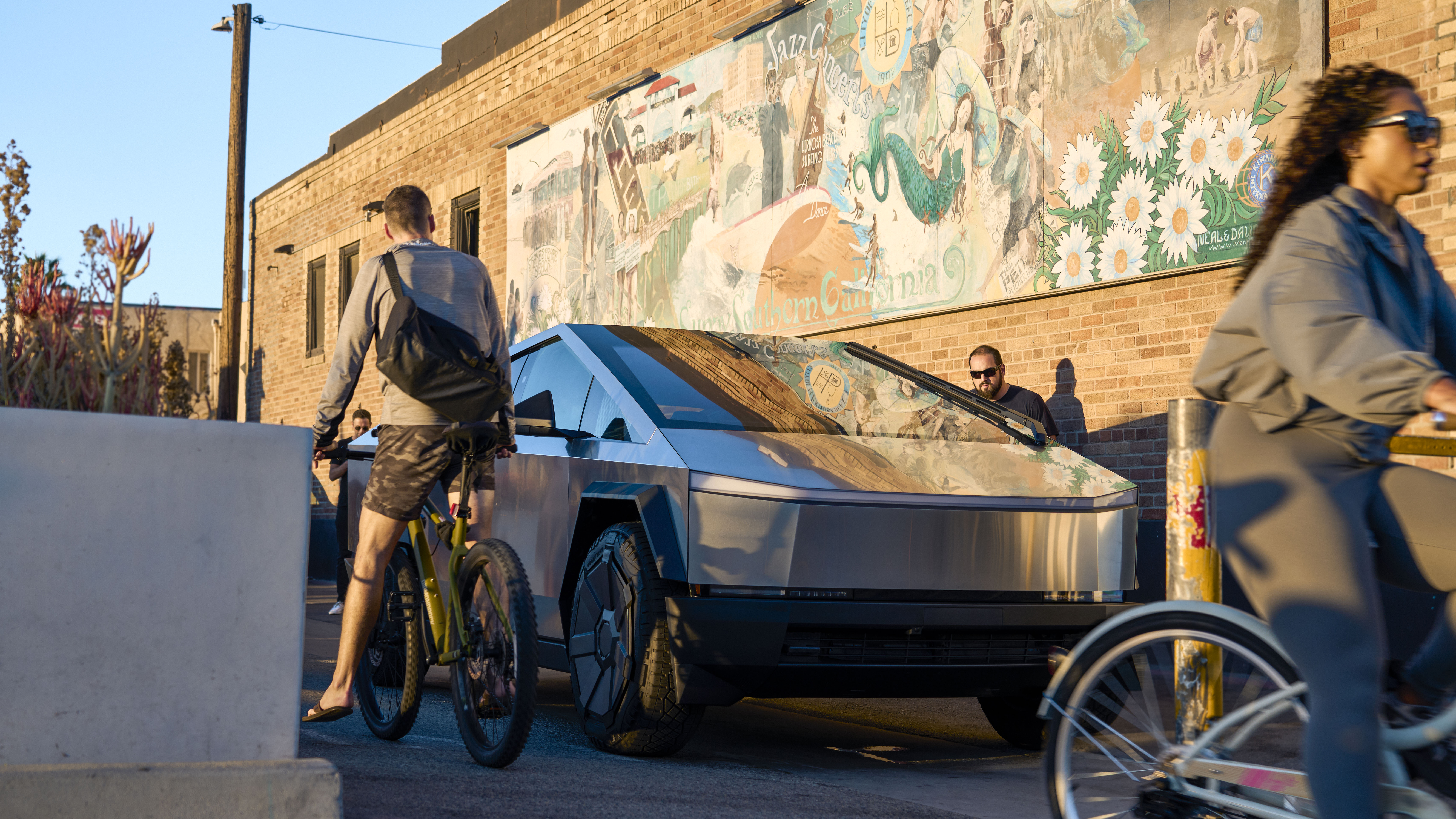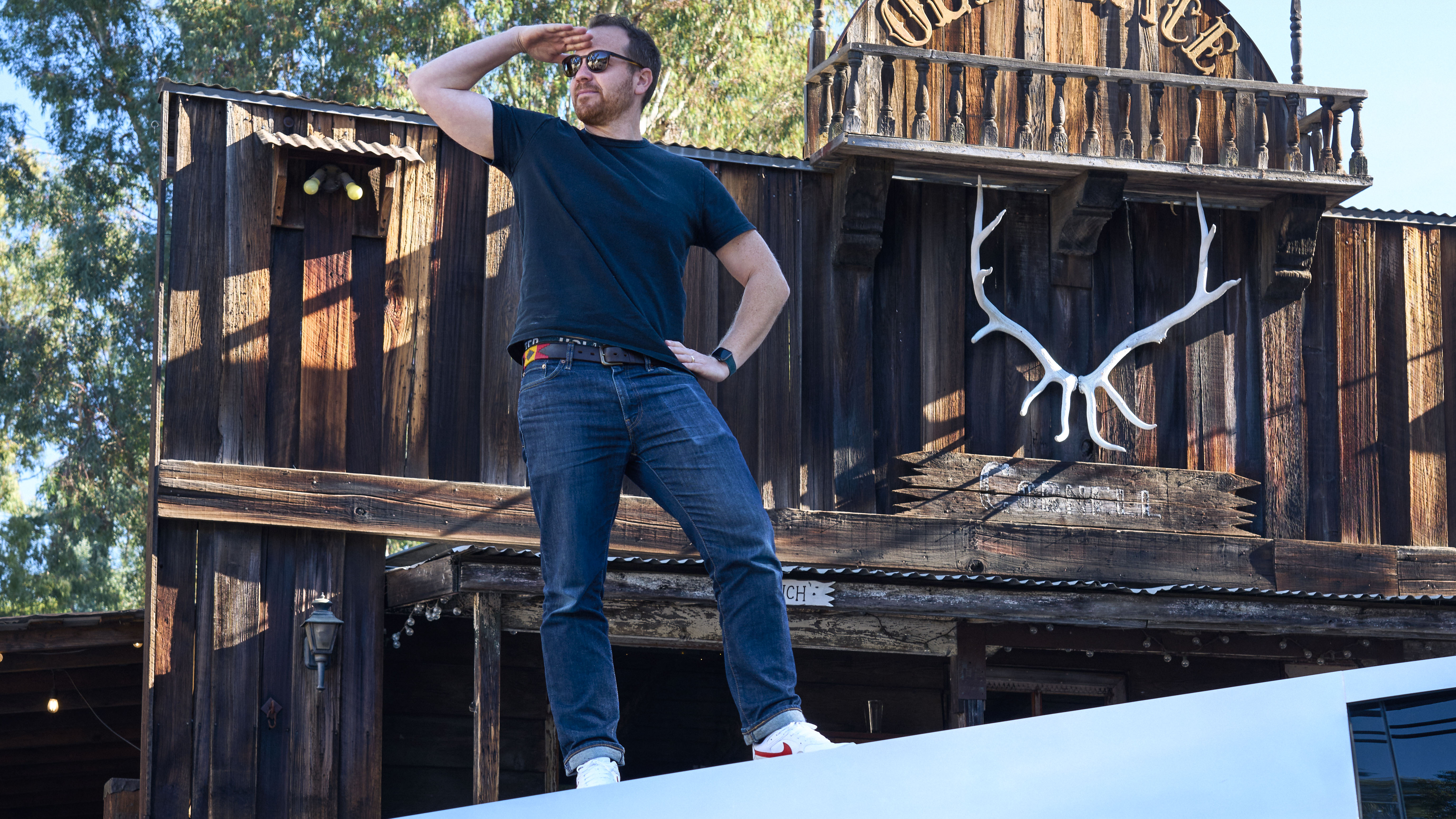
Robo-chop: seven questions for the new Tesla Cybertruck
Tesla’s stainless steel, armoured pickup truck was pure sci-fi fantasy... until now. Top Gear gets access all areas
“What do I think? I think it’ll never see the light of day,” says the perplexed gentleman standing next to what I have just explained is the production version of a pickup with first deliveries at the end of the month. Coming in hot, a barman has abandoned his post at a nearby restaurant for which his boss “scolded him a bit” but he doesn’t care because “it’s so beautiful”. He proceeds to polish the car off with a boozy rag and when I let him open the door... the hyperventilation begins.
The Tesla Cybertruck is less a vehicle, more an A-list celebrity, hounded wherever it goes. Every move recorded, every morsel of information twisted and reinterpreted until none of it makes sense. It’s a self-fuelling frenzy – every mention sends clicks rocketing, every picture gets social media fuming, or evangelising, but mostly fuming because calling out how dumb it is, or how laughably it’s put together based on phone snaps of a prototype, has become the internet’s favourite game.
To be fair to the keyboard critics, Tesla has brought it upon itself. Since the concept’s reveal to several billion gasps in 2019, with Musky promises of 2021 production and a $40k starting price, it’s lurched from one crisis to another. Design director Franz von Holzhausen smashing the ‘unbreakable’ windows with a metal ball on stage was just a taste. There followed multiple delays, leaked testing reports citing woeful soundproofing and dangerous brakes, and Elon’s now famous email insisting the Cybertruck be “built to sub 10 micron accuracy [because] if Lego and soda cans, which are very low cost, can do this, so can we”... as prototypes with panel gaps like rugby posts rolled around on public roads. Finally, Elon’s admission that “we dug our own grave with the Cybertruck” and they probably won’t hit full production of 200,000+ trucks a year at Giga Texas until 2025.
Photography: John Wycherley
We understand, perplexed man, your reluctance to believe it’s finished. We can barely comprehend it ourselves. So, how has the world’s most valuable car company dragged Elon Musk’s vision of an armoured personnel carrier from some dystopian future kicking and screaming into reality? Does it work as an actual truck? To find out we had two days in LA grilling the key players and driving it ourselves. We shall now be taking questions...
WHAT’S THE REACTION LIKE?
Like Taylor Swift just rolled past on a unicycle in Lady Gaga’s meat suit. The constant and intense attention this truck gets is unlike anything I’ve experienced. Even before we’ve left Tesla’s Design Center car park there are employees queuing up for selfies, and they’ve probably worked on this for years. Whether in dumbstruck disbelief, mild anger or breathless euphoria there’s a magnetism to it that’s beyond the human brain’s control. You have to take a look, take a picture, post a video, tell a friend, yell something or just stand there, slack jawed and rubbing your eyes.
Honesty time. I like how the Cybertruck looks. I love how it sticks two fingers up at anything that’s gone before, that it aggravates some people and fills others with a sense of wonder. I marvel how full of risk it is and how confusing it is to look at, from just about any angle... and that Toblerone will probably be filing a lawsuit any day now. It’s barmy, not by adding wings, slashes, vents and stripes, but by setting fire to design convention and peeing on the ashes. It’s brutal, not beautiful, but commits 100 per cent. It’s all in. I love that.
Here comes a leathery surfer dude who keeps telling his buddy it’s a movie car, even when a Tesla engineer tells him it’s not. Or the lady who owns three Teslas and is a Cybertruck deposit holder... but had to wait so long she bought a Rivian R1T instead. I particularly enjoy the couple who calmly ask where they put their stuff, then have their minds blown when I hit a couple of buttons to roll back the tonneau electrically and drop the tailgate. I’m sitting inside behind tinted glass when the video team helpfully tells a group of teenagers that I am, in fact, Elon Musk. They start yelling and leaping about, swiftly followed by crushing disappointment when a balding British bloke emerges a few minutes later.
I see parallels with the Countach back in the Seventies. The Cybertruck is born to shock, but arguably goes further than Gandini’s wedgy masterpiece, because it’s not a supercar. Tesla has chosen the most utilitarian vehicle genre of all, the one that has forever put function before form. Say it out loud: the most exotic looking production car in the world is a pickup truck.
IS IT REAL?
Yes it is. Stop rolling your eyes at the back. By the time you read this one of Tesla’s handover events will have occurred in Texas, with the first group of extremely patient customers getting their keys to a spanking new truck. Choices to begin with include the tri-motor version we’re driving, known internally as The Beast, costing around $100k in launch edition trim (a little less down the line) and a less powerful, longer range, more affordable dual motor. Eventually a RWD single motor will arrive. You can have it in any colour you like, so long as it’s bare stainless steel, and prices haven’t been confirmed at the time of writing, but fair to say a $40k starting price isn’t going to happen... a RWD will probably add $20k to that.
Still, you’re getting a lot of truck – at just under 5.7m long it’s shorter than the Ford F-150 Lightning (it was scaled down fairly late in the day at Elon’s request, to save cost, material and boost performance), but at 1.85m long and 1.3m wide, it has the bigger bed.
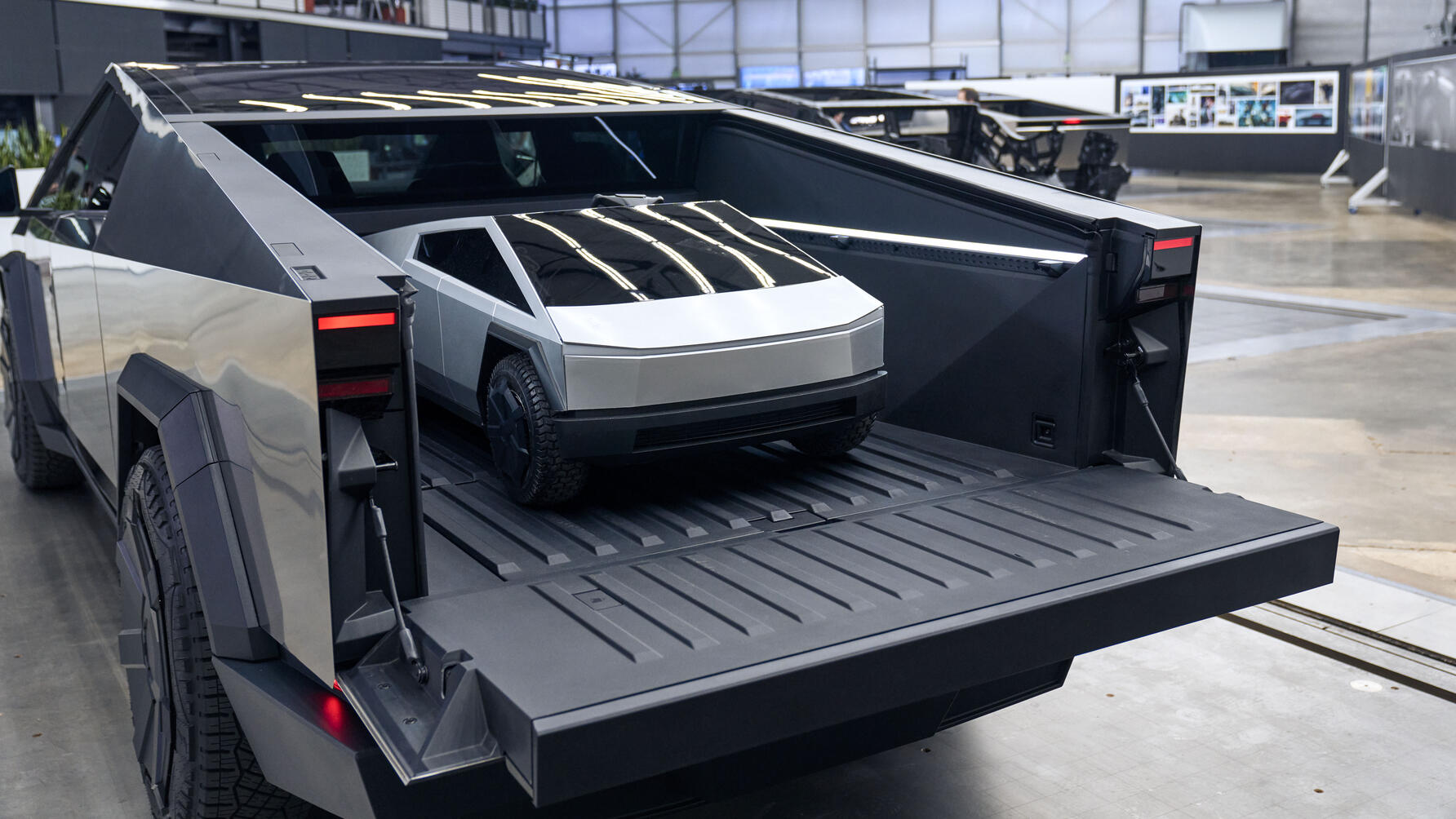
The tri-motor features two induction motors on the rear axle and a permanent magnet motor on the front (the tri-motor Model S Plaid is all permanent magnet). It produces well over 900bhp, can crack 0-62mph in under 3.0secs, weighs just over three tonnes and has a 123kWh battery – Tesla’s biggest yet. Claimed range is around 325 miles (roughly in line with the F-150, although Tesla will offer an optional 50kWh battery extender – essentially the pack from an entry Model 3 – that bolts into the bed and takes up some cargo space, but extends range significantly). The 800V powertrain, a Tesla first, will charge at up to 350kW if you can find a V4 supercharger, and is entirely designed and built in-house by Tesla.
WHY DOES IT LOOK LIKE THAT?
For this I must defer to design chief Franz von Holzhausen, who I’m sitting opposite in Tesla’s LA design centre, just down the block from SpaceX HQ. Behind him is the original clay model, an early prototype, the body in white and a production Cybertruck. Alongside Franz is Lars Moravy, Tesla’s VP of vehicle engineering.
Top Gear
Newsletter
Thank you for subscribing to our newsletter. Look out for your regular round-up of news, reviews and offers in your inbox.
Get all the latest news, reviews and exclusives, direct to your inbox.
Franz goes first. “It started out as ‘What would a Tesla pickup be?’ We started unpacking existing pickup trucks and realised that the market hasn’t changed at all. They’re all body on frame, which is 60 or 70 years old, and they all look the same. In the beginning we started going down a couple of avenues that were unique, but not really dramatic enough.
“In the early days we had a Lotus Esprit in the studio, the submarine car, and then started looking at what else was in this simplistic, angular theme - stuff like the F-117 Nighthawk and the Countach. Like Gandini, we wanted to do something dramatic that changed everything. I was getting frustrated with the process and secretly started drawing something radically different. It was really this simple idea that I had right in the beginning, this exoskeleton idea, a low resolution-looking type of truck. And out of that side project we made a full size model to show Elon. And he’s like, ‘That’s what we’re doing’.”
From an engineering perspective Lars had a slightly different take. “When it was first introduced there was a lot of consternation because it’s our job to make dreams a reality, but when you look at the shape, the stainless steel and the additional bit that Elon threw in that it had to drive like a sports car but have all the utility of a pickup truck... basically, we were sweating bullets.
“On top of that Elon wanted the first prototype in 90 days, which he did to drive decisions. There’s no time to argue it, there’s no time to pontificate about what could be, would be, should be. You’ve just got to pick the best thing and go.”
HOW DOES IT DRIVE?
Shorter than an F-150 Lightning it may be, but from where I’m sitting, weaving through LA traffic, it doesn’t feel particularly petite. Even in America where everything is supersized, the Cybertruck is an absolute tank.
I’m not saying it’s difficult to drive – you glide through town with all that torque masking mass, in a pyramid of calm... until another Camry driver swerves in front of you to get the perfect angle for their TikTok, a periodic reminder of just how bats**t the thing you’re driving looks from the outside. There’s a blind spot behind the chonky A-pillar and zero rear visibility with the tonneau cover in place (instead you get a rearview camera feed at the top of the screen – ironically it has proper wing mirrors as cameras aren’t yet legal in the US), but I never have any difficulty placing it on the road or parking up.
The hardest part, not being a regular Tesla driver, is trying not to crash as I prod wildly at the 18.5in central screen, trying to recall where everything is. Yep, the Cybertruck does away with an instrument panel and buttons are NFI – all that stretches beyond the squircle steering wheel is several acres of dashboard and a windscreen finishing somewhere past the front axle. The ride on the self-levelling air suspension is cushioned, the wind noise well suppressed and the shudder, rattle and roll I’m expecting to feel when we hit a pothole doesn’t materialise. So far, so car-like.
We need to talk about the steering. Forget the wheel that can’t decide whether it’s a circle or a yoke (jobs for the facelift: the former would be infinitely easier to use), the big story is steer by wire, which means that there’s no physical connection between the squircle and the front tyres... or the rears for that matter as there’s also four-wheel steering. So the turning circle is less than a Model S (feels miraculous, endlessly handy) and the wheel only needs 170° in either direction lock to lock, which is less than a full turn in total. The idea is that you never need to take your hands off the wheel, and a constantly variable ratio means you can turn sharply with little effort at low speeds and carve about smoothly when you’re going quicker. Unfortunately, the effect around town is a rack that feels livelier than an Eighties banker on a Friday night.
Twitch your wrists and the nose darts away, and then with the rear tyres turning up to 10° in the opposite direction, the sensation is the truck rotating about its centre point. I get the thinking – remove wheel twirling entirely, make it feel pointy and precise at low speeds, everything that traditional trucks are not, but the caffeine dose needs rethinking. It’s something I learned to put up with, but couldn’t gel with even after a couple of days with the Cybertruck. Tesla’s response? Over the air updates – there’ll be one state of steering tune at launch but the mapping can be tweaked infinitely in the future, nothing is set in stone. We shall see.
The good news? Find a few curves up in the hills above Malibu and with some speed under the wheels the steering ratio knocks back from manic to manageable. Now you start to carve out some proper speed, revel in most un-truck-like stability and noticeably less body roll than the Hummer EV and F-150 Lightning, the other two battery laden pickups I’ve tried. Look, it’s not a bloody sports car, but it puts traditional trucks in the shade. As ever, the key here is smooth inputs and respecting the laws of physics, otherwise understeer awaits – on the road at least, the engineers insist that much controllable oversteer can be served up when you find a loose surface.
I don’t doubt it, because it is obscenely rapid for something this large. A big step up from both Hummer EV and F-150 Lightning, especially when you select ‘Beast’ driving mode, stamp on the brake and the throttle at the same time, hypnotise yourself with the ‘Cheetah mode’ graphics on the screen as the front squats, then release the brake to unleash an avalanche of acceleration. Does a pickup truck need to be this fast? Of course it doesn’t, but drag racing has always been Tesla’s party trick, why stop now?
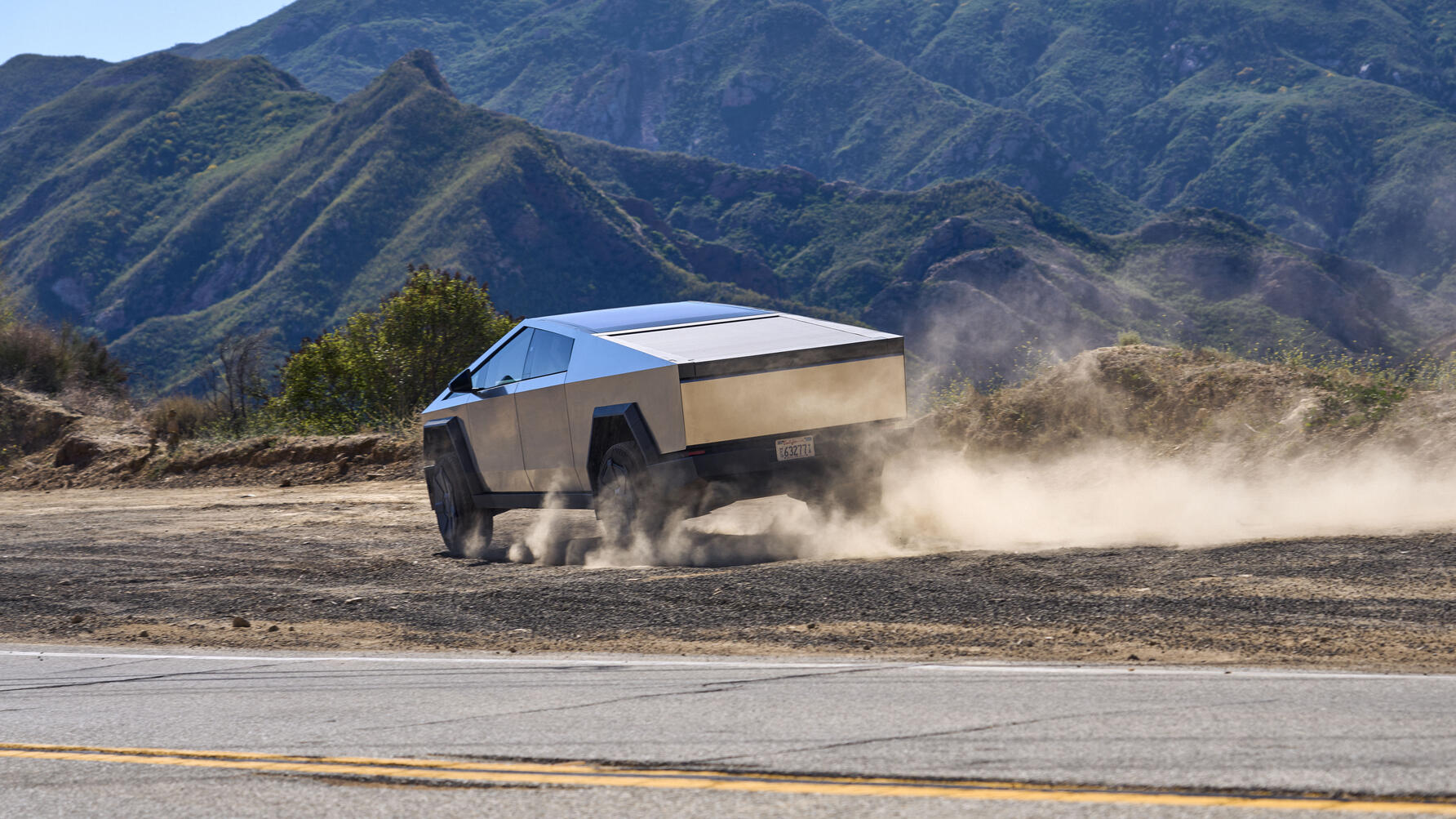
WHAT'S IT MADE FROM?
Stainless steel panels bolted directly onto a steel monocoque forming a literally bulletproof exoskeleton. A truck that wears its toughness on the outside... is the elevator pitch. As ever, getting Elon and Franz’s Delorean-gets-jiggy-with-an-F-150 vision to work was easier said than done.
Over to poor old Lars. “Turns out it’s really hard to bend stainless steel, and when you do bend it, you get orange peel marks on the crease and there’s no paint to hide it. There’s no stamping, the steel can only bend in one direction, so we had to invent something new. It’s a process called ‘Airbending’ where we actually float the tool on a sort of high pressure air hockey table, so it’s not actually touching the surface when bending it. That probably sounds simple, it’s not.
“To start with we had aluminum concepts, we had normal steel concepts, and we could have ended up with the same aesthetic, but it would’ve required an inner strengthening structure and been angular for the sake of being angular. It has to be that way with stainless steel. We call the material HFS – hard freaking stainless – it’s a special grade because stainless is not stain proof, it does corrode over time. And so we had to add various elements to the mix to make it resistant, get that full hardness and have just enough ductility to bend it.”
There’s no ‘hemming’ though, where you “wrap the outer around the inner like in a traditional panel”, which means all the edges are exposed. They’re chamfered to avoid dicing your fingers, but it takes getting used to. You wouldn’t want to slip in your garage and meet certain corners on the way down. Only one piece has a strip of rubber to protect you, the bottom edge of the frunk because when open it’s bang on head height.
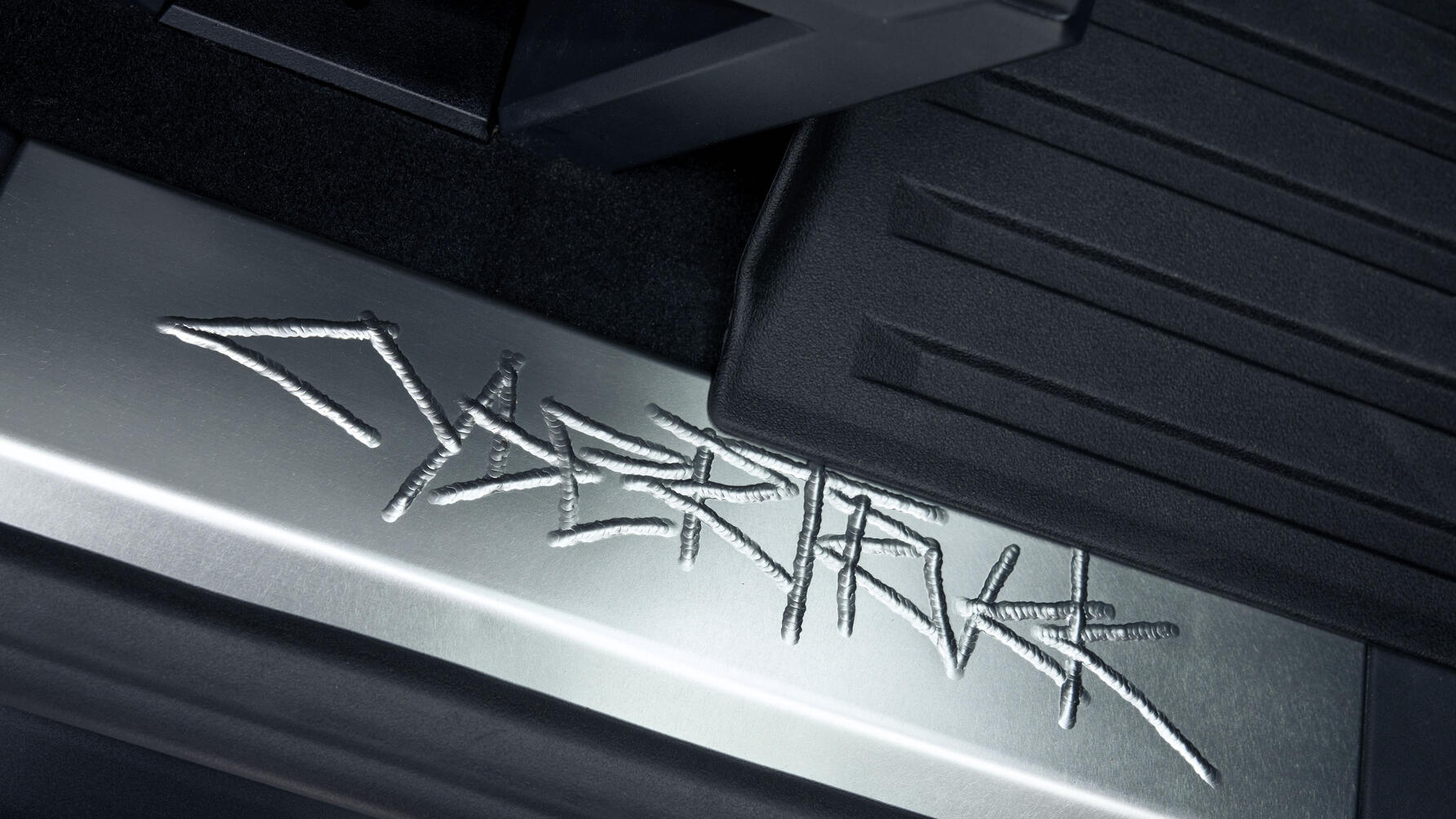
The bare metal and flat surfaces look spectacular in pristine condition, but attract fingerprints, and in harsh direct light you notice a slight rippling effect on the largest flat areas. Two options if your OCD is ticking – carry a bottle of window cleaner to wipe it down, or get some dirt on and stop caring. And fear not, the tolerances and alignment have tightened for production, but there are quirks in the way the panels meet, look and feel. The way A-pillar joins the front quarter panel is particularly... quirky, but I’m OK with that, it’s built differently, these are not panels as we know them.
“The cool thing about repairing it is because it’s a scratch finish, depending on how deep you go, you just get some Scotch-Brite but rub it out. Getting a dent is not easy, it’s a serious event,” Lars explains. Serious as in getting shot at?
“It’s not going to stop an armour piercing bullet, but we did empty the clip from a Tommy gun in the side, no problem. We’ll offer the option to make the windows bulletproof and the windscreen (the largest single sheet of glass in automotive manufacturing) is made out of a borosilicate glass, so a chip gets a little ring around it so it doesn’t propagate.”
CAN IT DO TRUCK THINGS?
We’re yet to test the Cybertruck off-road beyond a dusty lay-by, but the ingredients sound promising. Like air suspension with a total range of 14 inches (for max ground clearance of 20in) and all-terrain tyres as standard (though you can opt for more efficient, slightly quieter road-biased rubber if you prefer). An e-diff locks up the front axle, but the two rear motors control each wheel individually so you don’t need one at the back.
The Cybertruck doesn’t just fancy itself as a rock crawler – beyond the standard off-road mode there’s a ‘Baja’ setting with a front/rear torque split slider for when only fast and very loose will do. The engineers were raving about its jumping ability when they took it for a hoon in Mexico. It can tow up to five tonnes, which will slice your range at least in half, so the extra battery is a must. We’re told the accessories catalogue is “extensive”.
There are three plugs in the bed, which are powerful enough to allow welding or more likely for plugging in your mini fridge for a spot of tailgating. Open the electric frunk and there’s space to tailgate (frailgate?) there too, or cram a few more big bags in, but the star of the show is the load bay cover. That retracts speedily down the back of the bulkhead when you hit a rubber button and turns the bed into an enormous, lockable boot. It also improves aero efficiency by 10 per cent when closed and can support a 25 stone person “standing on one leg” says Lars. This is the type of relevant product information we like.
The interior is typical Tesla, simplistic to the point of barren, better built than Teslas of yore but still no BMW. A large storage bin under the front armrest, two hexagonal cupholders and a glovebox that glides out and back electrically with space for a laptop. In the back is a three-seat bench with seat squabs that fold up, and the rear door opens to 90° meaning you can post 2m-long things in there easily, including sleepy humans if you’re caught short.
SHOULD I BUY ONE?
Were you one of the millions who put a $100 deposit down to buy a Cybertruck all those years ago? If you loved it then, and can absorb the price increases, you’re still going to love it now. Tesla has done the rarest of things – albeit much later than promised – and delivered to production, in effectively unchanged form, the sci-fi fantasy concept truck we first saw back in 2019.
However, if you live in the UK, or anywhere other than North America, we’d get on the phone to Elon and ask for your cash back. Pedestrian protection with that unyielding front end is a big no for export, for now, but Lars boils it down to two other things. “One, the truck market in the US is huge and two, European regulations call for a 3.2mm external radius on external projections. Unfortunately, it’s impossible to make a 3.2mm radius on a 1.4mm sheet of stainless steel.” Unlikely we’ll ever see a Cybertruck wedged into a London width restrictor, then, but would we want to? Honestly it’s a size or two too big for over here, and a few will filter through as grey imports anyway.
But the achievement here isn’t flooding the world with Cybertrucks – that’s what the whitegood Model 3, Y and more affordable future models are for - it’s the bloody-minded engineers pushing this through to production through sheer stubbornness and bottomless development budgets. There’s work to do on the way it drives, we need to set it an off-road examination, but it’s a proper truck alright and one that adheres to Tesla’s unconventional philosophies. Love it or hate it, it’s real. The Cybertruck has landed and nothing will be quite the same again.
Trending this week
- Car Review
BMW iX3








